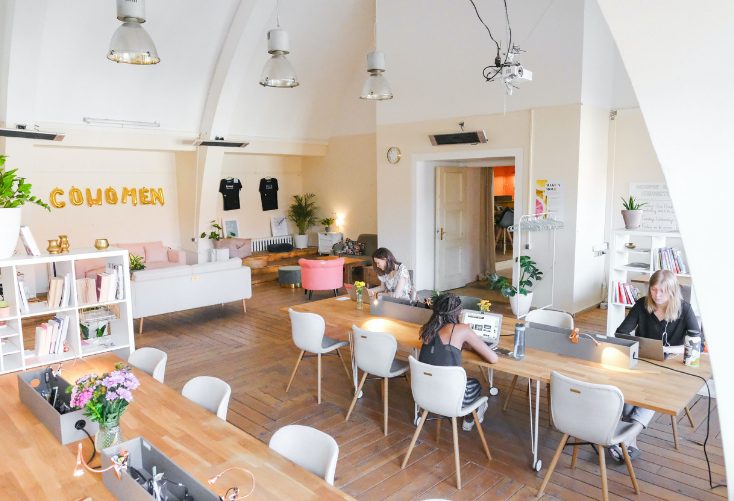- Become part of a community of fellow freelancers
- Memberships typically work on a monthly rolling basis
- You can finally press the “off” switch at the end of the day
At first, the ability to work from home seems like one of the biggest perks of being a freelancer. Yet while it certainly is a privilege, for many us, the novelty quickly wears off.
If you’ve ever suffered from isolation, claustrophobia or a general lack of motivation while working from home, you’re not alone. According to recent research by Totaljobs, 46% of workers have experienced loneliness while working from home.
But what’s the alternative?
Enter the shared workspace: the flexible and affordable antidote to working from home (that might even gain you more clients). In this article, we’ll guide you through every corner of the shared workspace concept, from it what it actually means to how to find one.
- What is a shared workspace?
- What are the benefits of collaborative workspaces?
- How do I find and rent a shared workspace?
What is a shared workspace?
Shared workspaces take many different forms. This might sound a little confusing and obtuse but it’s actually a good thing:
It means there’s something out there for everyone.
Broadly speaking, a shared workspace is a building, or a floor in a building, that is set up for work purposes. It contains desks, kitchen facilities, lounge space and meeting rooms.
But instead of the space being let by the landlord (or “operator”) to one large company, it’s rented out to multiple smaller companies and individual freelancers/contractors.
“It sounds nice in principle, but it must be super noisy and cramped, right?”
Wrong. Shared workspaces are often spacious and well planned out. They have to be – there are so many options out there now that in order to compete, the people who run these spaces need to get them right design-wise.
That means different configurations to meet different requirements. Picture this:
You wake up one morning and decide to go and check out a shared workspace. You’ve found one you really like the look of on AllWork and arrange to go and view it in the afternoon.
As you walk through the door you’re greeted by a community manager who signs you in.
They’ll be showing you around the workspace. The first stop on your tour is the coworking space. It’s a large open-plan area with people working on their own projects.
Some have noise cancelling headphones on while others are working quite contentedly to the low tempo music playing in the background.
Next, they show you the private offices. There’s a two-person startup in one, a team of ten in another and a one-person office that’s currently vacant (your interest is piqued).
After showing you around the communal facilities – including a kitchen stocked with coffee and snacks, a breakout space with sofas, booths for taking virtual calls in and two meeting rooms kitted out with the latest AV tech – they bring you back to reception.
You take some time to mull it over. You love the space, but do you want to rent a desk in the coworking area or would it be better to pay a bit more and grab one of the private offices?
Another option is to start off with a virtual space and scale up from there.
Types of shared workspaces – shared workspace definitions
Let’s take a more structured look at your options when it comes to shared workspaces.
Private office
You can rent a private office in a shared workspace. Private offices are suited to small teams who require a little, well, privacy.
If the office is pre-furnished (most shared workspaces are), the ergonomic chairs and desks are already in place when you move in.
All you and your team need to do is bring your tech and connect to the WiFi.
Lots of freelancers, consultants and independent contractors rent private offices for one (or sometimes two) people. Especially those who deal with sensitive information, take lots of calls or have a lot of tech equipment, so need space to spread out.

Coworking space
A coworking (or ‘communal’) space is the perfect fit for many solopreneurs. You can usually opt for one of two memberships types: a hotdesk or dedicated desk.
With hotdesking, you’re not guaranteed use of the same desk every time.
Some hotdeskers tend to use shared workspaces on a more ad-hoc basis. They might split their time between working from home and in the coworking space.
Others use it every day but can’t afford a dedicated desk, or simply aren’t bothered about using the same desk every time because they work from a laptop.
Dedicated desks do what they say on the tin: they provide you with a desk that nobody else can use. You can set up your monitors, add a few pot plants and really make it your own.

Virtual space
If moving straight into a shared workspace feels like too much of a leap, you can always opt for a virtual office and move into a physical space later on.
Virtual space memberships can provide you with:
- A business address and telephone number
- Mail forwarding and scanning
- Discounts on meeting rooms in the operator’s physical space
- The option to hotdesk in the operator’s physical space
- Access to an online coworking community and events
Virtual spaces aren’t to be underestimated. As well as providing you with the benefits listed above, a business address in a prestigious location can work wonders for your brand image.
Sublet office
Lots of company directors are finding themselves with surplus office space on their hands at the moment, especially those who have recently implemented hybrid work strategies.
You may be able to sublet a desk space from one of these companies for a competitive price. Sure, it means you’ll be sharing with a team that isn’t connected to your business, however it can provide you with a space in which to focus.
And you might end up making some valuable connections.
Timeshare office
You’ve probably heard of holiday let timeshares.
Well now shared workspaces are embracing the concept. Because an increasing number of freelancers, consultants and contractors are only looking for a desk a couple of days a week, workspace companies are renting out desks in their offices on a timeshare basis.
It works like this:
You might use the office space on a Monday and Wednesday, another freelancer might use it on a Tuesday and Thursday and on Fridays the space acts as a hot desk. As you can see, it’s super flexible, and as long as you stick to your time slots it can work superbly.
This isn’t an exhaustive list.
Shared workspace companies are coming up with new and inventive space types every day. There’s even talk of pay-by-the-minute booths!
What are the benefits of a shared workspace?
There are numerous benefits to working in a shared office or coworking space. An article published in Harvard Business Review explains why those who use them ‘thrive’ so much more than those who don’t.
It explains that people who use shared workspaces see their work as meaningful, have more control over how they work and feel like they’re part of a supportive community.
For us, it boils down to three things: wellbeing, productivity and connection.
1. A greater sense of wellbeing

Working from home for long periods can wreak havoc with both your mental and physical wellbeing. For example, sitting at the kitchen table on a non-ergonomic chair all day can lead to back problems and meddle with your work-life balance.
After all, dinner and emails don’t mix well.
Work-life harmony
Leaving work ‘at work’ is almost impossible to do when your workplace is your home. Having a desk in a shared workspace, on the other hand, can help give you some perspective.
It provides you with the time and space you need to create and maintain work-life boundaries, enabling you to dedicate quality time to both. You can finally press the “off” switch at the end of the day and focus on other things.
Shared workspaces are usually accessible 24/7, so you can easily arrange your work schedule around the rest of life’s commitments.
A space of your own
You can choose whether you want to work in a quiet place to really focus and get stuff done, or a more collaborative area of the building that’s conducive to creative thinking.
Either way, it’s reassuring to know that you’ve got a place you can rely on during working hours. Shared office memberships typically work on a monthly rolling basis making the whole arrangement super flexible and relaxed.
Less distractions, more mental clarity
Think about how much time you’ve wasted over the last year or more doing odd jobs around your apartment, making drinks for yourself and generally procrastinating.
Aside from your coworker’s cute new puppy, there are a lot less distractions in a shared office space. There’s also something about working around other people that just makes you focus better and for a longer period of time.

Structure to your day
Working in a community can help you create structure in your day.
You might grab a coffee as soon as you get to the office, hang out in the breakout space with a couple of coworkers for elevenses and head over to the local cafe on your own for a break at lunchtime. Not a bad routine.
Most freelancers know that it can be incredibly difficult to structure your day when you’re 100% WFH. We’ve all been there: working ‘till noon in our pjs, skipping lunch and responding to emails at midnight.
Once you’ve had a taste of the shared workspace life, it’s likely you’ll never look back.
2. Increased productivity

Time equals money when you run your own business. When you first work from home it can feel like you have all the time in the world. After all, your commute from the bedroom to the spare room, living or kitchen takes all of ten seconds.
However, many of us quickly realise that the time we save commuting is channelled back into…something, but we can’t put our finger on what.
More focused
Working in a shared workspace has the potential to make you more focused. It might seem counterintuitive – there are more people to chat to, for instance – but it’s true.
Focus is somewhat infectious: when we see other people knuckling down to work, we’re more likely to do the same.
There’s a flipside of course.
If you work in a communal space there might be times when you find it hard to focus, especially if there’s ever excessive chatter or jarring music playing. If you find yourself in this kind of environment, we’d recommend investing in some noise cancelling headphones.
3. Opportunities to connect

When we say ‘connect,’ we’re not referring to superfast internet (although that is another big plus). We’re talking about connections with other people. Those organic face-to-face interactions that educate and inspire us, and make us feel more proactive.
Collaboration
In the words of businessperson Marissa Mayer, “When you need to innovate, you need collaboration.” But it’s not always easy to make contacts as a solopreneur.
Shared workspaces are ripe for collaboration. Here’s why:
- They’re full of like-minded fellow freelancers and business owners
- Some might not be on the same wavelength, but that’s fine because it’s healthy to have our viewpoints challenged every now and then
- You’ll find a variety of specialists from different industries – people whose expertise you can utilise for your own business
- Many shared space operators run networking events and social gatherings where you can get to know fellow coworkers on a personal level
- Skills sharing is commonplace
New ideas
If you’re going through an uninspired phase, don’t panic. Coming up with ideas on your own is challenging at the best of times, let alone at a time when many of us have had to confine ourselves to our own homes due to lockdown restrictions.
Working alone at home can also leave you feeling like you’re losing your identity.
At times like these, a simple change of scene can be just what you need. Find inspiration in the artwork on the walls of your shared workspace or bounce some of your ideas off a fellow coworker at the coffee machine.
In other words, get away from your home to get back to feeling more like you.
“Working amidst people doing different kinds of work can also make one’s own work identity stronger.”
Harvard Business Review, ‘Why People Thrive in Coworking Spaces’
Promotion
Your shared workspace can also act as a platform for promotion. Many flexible workspace operators make an effort to champion their members and make sure the wider community knows about them. This can lead to more clients or sales, and ultimately…
Growth.
If you’re a freelancer, consultant or contractor who wants to grow their business and eventually hire some employees, we’d totally recommend trying out a shared workspace.
Once you get your foot in the door, it’s easy to scale up. Take this trajectory, for instance:
- Month 1-3: a hotdesk membership
- Month 4-12: a dedicated desk membership
- Year 2-3: a five-person private office (in the same building)
- Year 3-5: a ten-person office (in the same building)
- Year 5 onwards: a 20-person office (in another building managed by the operator)

How do I find and rent a shared workspace near me?
With so much choice out there, it can be difficult to know how and where to start looking for a flexible workspace. Don’t panic: we’re here to make the process more straightforward.
Choose the right type of shared workspace
The first step is to build a picture of what you need. Outlining your requirements will make the searching process much easier.
Here’s a list of key considerations.
Consideration #1: Which type of shared workspace do you need?
Do you want a hotdesk, dedicated desk, private or sublet office; or a virtual office, perhaps?
The type of shared workspace you choose will depend on the type of work you do, your budget and your overall preferences.
As we mentioned earlier, if you have confidential calls with clients it’s likely that you’ll need somewhere a little more private. Likewise, if you’re after a silent environment, working in a busy coworking space might not cut it.
On the other hand, after so much time spent in relative isolation, you might be aching to feel the buzz of being around people again.
In this case, bag yourself a coworking membership asap.
One of the great things about shared workspaces is that you get to meet people working in a variety of industries. There are, however, industry-specific workspaces out there designed for people working in tech, education, the arts…the list goes on.
If you’d like (or need) to bring your dog to work, you’re in luck. A growing number of spaces are introducing ‘pet friendly’ policies. As long as you abide by the rules and your pet doesn’t disrupt other members, they’re usually more than welcome.
Some shared workspaces even have flexible childcare facilities on site!

Consideration #2: How many days a week do you want to use it?
Do you need a full-time space or are you looking for something more ad hoc?
Research by Spacelab_ reveals that 73% of people would like to WFH at least two days per week. If you fall into the category, a part-time membership could be the way forward.
The great thing about these memberships is that you can often switch it up at short notice.
So, you might start off on a two-day a week agreement and change it to a full-time one after a couple of months.
Full-time memberships often come with a small lockable storage unit to keep your belongings in. It varies though, so always check with the operator first.
Consideration #3: What location are you looking in?
There has been a clear shift in demand for ‘out of town’ coworking recently. Rising living costs and a desire to cut carbon emissions are two main factors driving this trend.
New shared workspaces in the suburbs are opening up every month to meet this growing appetite for non-city working.
But, again, it really boils down to your requirements and preferences. Some people love working in the centre of things, with easy access to theatres, cinemas and restaurants.
It might be that a city centre location suits your clients more too. If your work does involve meeting with clients, be sure to check out the local and international transport links.
Consideration #4: Do you need any specific amenities?
What are your non-negotiables? Most shared workspace come with the essentials: ergonomic chairs, desks and, of course, the humble coffee machine.
The majority are also fitted out with WiFi.
If your work involves lots of uploading and downloading, you may want to opt for a space with high speed fibre broadband.
Superfast broadband speeds start at 24 megabytes per second (Mbps), up to 300Mbps.Ultrafast broadband is anywhere between 300Mbps and 1000Mbps (one gigabit per second, or 1Gbps).
Consideration #5: What’s your budget?
According to DeskMag, the average monthly price for a dedicated desk in the US in 2019 was $387 and the average monthly cost for a hot desk was $195.
Prices vary according to the location and quality of the space. Bear in mind that lots of operators are offering deals at the moment in a bid to attract new members following the lockdown.
So if you’re considering taking the step, now could be the best time.
How can Allwork help me find a shared workspace?
When it comes to actually finding a workspace you have three options:
The first one is ‘word of mouth’.
This can be particularly effective if you’re looking for a desk space in your local neighbourhood. Speak with other local freelancers and business owners in your area to get the lowdown on where’s hot and where’s not.
The second is search engines.
Simply type in “shared office in New York”, for example, and away you go.
HOWEVER:
If you go down the search engine route, you’ll only ever get a snapshot of what’s available. The workspace companies with bigger budgets will rank higher because they can afford the ads.
In reality, there might be a smaller independent or niche workspace that’s more suitable, but doesn’t rank highly on the search engines so gets lost in the noise.
The third way is to use a workspace platform like AllWork to find a shared workspace. We’ve aggregated over 15,000 workspaces worldwide onto our site, making it easier than ever to find the perfect workspace for your needs.
What’s more, we’ve got a team of experts on hand to help find the right shared space for you. They can help you figure out what you need and will even negotiate the price on your behalf.
Start exploring your options today: allwork.space/flex-space.
FAQs
- What is a shared workspace?
- A shared workspace is a workspace that you share with other professionals and businesses. You can opt for a desk in a communal coworking space, a private office with shared amenities, a sublet, timeshare or a virtual office solution.
- What are the benefits of a shared workspace?
- Shared workspaces can boost your wellbeing, make you more productive and give you access to a community of like-minded solopreneurs. They provide people like you with a spacious desk area and high quality business amenities.
- How do I find the right shared workspace?
- Firstly, you need to define your requirements. Think about whether you’d like a coworking desk, private workspace or a virtual one. Think about how much you’d like to spend, the location (city centre or suburbs), and list any ‘must-have’ amenities.
- How can Allwork help me find a shared workspace?
- To find the right shared workspace for you, visit allwork.space/flex-space. Just type in the location you want to work in and the algorithm will do the rest. Gain access to over 15,000 spaces worldwide and get free support throughout the process.
- How much does it cost to rent a shared workspace?
- The cost of a shared workspace varies depending on where in the world you’re looking. In the US, the monthly price for a dedicated desk is $387 and the average monthly cost for a hot desk is $195. Many operators are offering reduced rates at the moment.


 Dr. Gleb Tsipursky – The Office Whisperer
Dr. Gleb Tsipursky – The Office Whisperer Nirit Cohen – WorkFutures
Nirit Cohen – WorkFutures Angela Howard – Culture Expert
Angela Howard – Culture Expert Drew Jones – Design & Innovation
Drew Jones – Design & Innovation Jonathan Price – CRE & Flex Expert
Jonathan Price – CRE & Flex Expert













